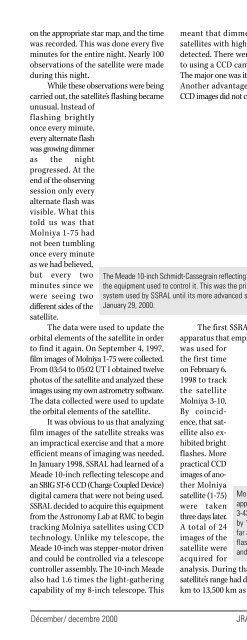I N S I D E T H I S I S S U E
insidethisissue - The Royal Astronomical Society of Canada
insidethisissue - The Royal Astronomical Society of Canada
- No tags were found...
Create successful ePaper yourself
Turn your PDF publications into a flip-book with our unique Google optimized e-Paper software.
By the middle of the twentiethcentury, nuclear physicists andastrophysicists could calculate theoreticallythe rate of nuclear burning in the interiorsof stars like the sun. But, just when wethought we had Nature figured out,experiments showed that fewer solarneutrinos were observed at earth thanwere predicted by the standard theory ofhow stars shine and how sub-atomicparticles behave.At the beginning of the twenty-firstcentury, we have learned that solarneutrinos tell us not only about the interiorof the sun, but also something about thenature of neutrinos. No one knows whatsurprises will be revealed by the new solarneutrino experiments that are currentlyunderway or are planned. The richnessand the humor with which Nature haswritten her mystery, in an internationallanguage that can be read by curiouspeople of all nations, is beautiful, awesome,and humbling.ReferencesF. W. Aston, “The Mass-Spectra ofChemical Elements,” PhilosophicalMagazine and Journal of Science, 69,611-625 (1920). In the course of asystematic program to measure themasses of atoms, Aston found thatfour hydrogen nuclei (protons) areheavier than a helium nucleus (an alphaparticle) and two positive electrons[see Eq. (1)]. This fundamental discoveryis the experimental basis of ourunderstanding of how stars like thesun shine. The original paper is rarelycited, perhaps because the text is mainlydevoted to a description of Aston’s newapparatus and to a discussion of themany different masses that he measured.The hydrogen-helium mass differenceis only briefly mentioned.R. D. E. Atkinson and F. G. Houtermans,“Zur Frage der Aufbaumöglichkeit derElements in Sternen,” Z. Physik 54, 656(1929). An early attempt to calculatethe rate of nuclear reactions in starsusing the Gamow factor.J. N. Bahcall, “Solar Neutrinos I. Theoretical,”Phys. Rev. Lett. 12, 300 (1964).H. A. Bethe, “Energy production in Stars,”Phys. Rev. 55, 436 (1939). If you are aphysicist and only have time to readone paper in the subject, this is thepaper to read.J. D. Burchfield, Lord Kelvin and The Ageof the Earth, (Chicago: University ofChicago Press), 1990. This concise bookprovides a clear and insightful accountof Kelvin’s views on the age of the earthand the age of the sun, and on manyother topics including natural selectionand geological evolution. The authortells an exciting story with historicalaccuracy.C. L. Cowan Jr., F. Reines, F. B. Harrison,H. W. Kruse, and A. D. McGuire,“Detection of the Free Neutrino: aConfirmation”, Science 124, 103 (1956);F. Reines and C. L. Cowan, “Detectionof the Free Neutrino”, Phys. Rev. 92,830 (1953). These papers describe thefirst experimental detection of neutrinos.C. Darwin, On the Origin of Species byMeans of Natural Selection, or, ThePreservation of Favored Races in theStruggle for Life (London: Murray 1859),p. 285 [Pelican Preprint of first edition,296—297, 1968].R. Davis Jr., “Solar Neutrinos. II.Experimental,” Phys. Rev. Lett. 12, 302(1964).J. N. Bahcall and R. Davis Jr., “An Accountof the Development of the Solar NeutrinoProblem,” in Essays in NuclearAstrophysics, ed. C. A. Barnes, D. D.Clayton, and D. Schramm (Cambridge:Cambridge University Press 1982), p.243; reprinted in J. N. Bahcall, NeutrinoAstrophysics, (Cambridge: CambridgeUniversity Press 1989). For relatedmaterial, see http://www.sns.ias.edu/~jnb/Papers/Popular/snhistory.html.A. S. Eddington, “The Internal Constitutionof the Stars,” Observatory 43, 353 (1920).This lecture is inspiring.A. Einstein, “Zur Elektrodynamik bewegterKörper,” Annalen der Physik, 17 (105).English translation in The Principle ofRelativity, translated by W. Perrett andG. B. Jeffery with notes by A. Sommerfeld,(Dover Publications: New York), 1923.The logic in this paper is breathtakinglybeautiful and incredibly clear.E. Fermi, “Tentativo di una teoria dellaemissione di raggi ?” Ric. 4, 491 (1934).Reprinted in Enrico Fermi, CollectedPapers: Note e memorie, Vol 1. p. 538(University of Chicago Press: Chicago)(1962-1965). See also pp. 559, 575. Fermiformulated the mathematical theoryof neutrino emission in β-decay. Hisfirst paper on the subject was rejectedas “too speculative” for publication.W. A. Fowler, “Experimental and theoreticalnuclear astrophysics: the quest for theorigin of the elements,” Rev. Mod. Phys.56, 149 (1984).G. Gamow, “Zur Quantentheorie derAtomzertrümmerung,” Zeit. fur Physik52, 510 (1928). Derives the Gamowfactor using quantum mechanics.S. Hawking, “Gravitationally collapsedobjects of very low mass,” MonthlyNotices of Royal Astronomical Society,152, 75 (1971). In this imaginative paper,Hawking speculates that the centralregion of the sun might contain a blackhole and that this could be the reasonwhy the flux of solar neutrinos wasless than predicted.H. von Helmholtz, Lecture “On theinteraction of natural forces,” Königsberg,February 7 (1854), in Phil. Mag. 11[series 4], 489-518 (1856).J. F. W. Herschel, A Treatise on Astronomy(London 1833), p. 211.W. T. Kelvin, “On the Age of the Sun’sHeat,” Macmillan’s Magazine, 288-293(March 5, 1862).J. Marchant, Alfred Russel Wallace, Lettersand Reminiscences, I (London: Cassell1916), p. 242. Letter dated 14 April,1869.W. Pauli, letter to a physicists’ gatheringat Tübingen, December 4, 1930.Reprinted in Wolfgang Pauli, CollectedScientific Papers, ed. R. Kronig and V.Weisskopf, Vol. 2, p. 1313 (Interscience,New York) (1964).H. N. Russell, “On the Sources of StellarEnergy,” Pub. Ast. Soc. Pacific, August(1919). If you like to read mystery storiesand to figure out “Who did it” fromlimited clues, then you will love thispaper. A year before Aston’smeasurements of the mass of hydrogen226JRASC December / décembre 2000
















